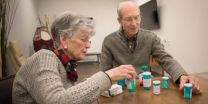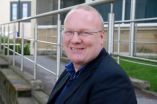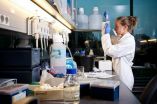(Press-News.org) Though just two of Hirono's 5,418 residents lost their lives in Japan's mega-earthquake and tsunami, a new study shows that the survivors are struggling to keep their sanity.
One year after the quake, Brigham Young University professor Niwako Yamawaki and scholars from Saga University evaluated the mental health of 241 Hirono citizens. More than half of the people evaluated experienced "clinically concerning" symptoms of post-traumatic stress disorder. Two-thirds of the sample reported symptoms of depression.
Those rates exceed levels seen in the aftermath of other natural disasters, but what happened in Japan wasn't just a natural disaster. Leaked radiation from nuclear power plants forced residents of Hirono to relocate to temporary housing far from home.
"This was the world's fourth-biggest recorded earthquake, and also the tsunami and nuclear plant and losing their homes – boom boom boom boom within such a short time," said Yamawaki, a psychology professor at BYU. "The prevalence one year after is still much higher than other studies of disasters that we found even though some time had passed."
Yamawaki got the idea for this study while shoveling mud from a damaged Japanese home one month after the tsunami flooded coastal towns. She had just arrived for a previously scheduled fellowship at Saga University. During her off-time, she traveled to the affected area and volunteered in the clean-up effort. One seemingly stoic homeowner broke down in tears when Yamawaki and her husband thanked her for the chance to help.
"She said 'This is the first time I have cried since the disaster happened,'" Yamawaki said. "She just said 'Thank you. Thank you for letting me cry.'"
Back at Saga University, Yamawaki collaborated with Hiroko Kukihara to conduct a study on the mental health and resilience of survivors. Their report appears in the journal Psychiatry and Clinical Neurosciences.
Participants in the study lived in temporary housing provided by the Japanese government when Hirono was evacuated. With an average age of 58, the people are noticeably older than the populations of normal Japanese towns. Yamawaki suspects that young people were more likely to permanently relocate elsewhere in Japan following the disaster.
The researchers didn't just measure the rates of mental illness; they also performed a statistical analysis to learn what fostered resilience among the survivors. Eating right, exercising regularly and going to work all promoted resilience and served as a buffer against mental illness.
"Having something to do after a disaster really gives a sense of normalcy, even volunteer work," Yamawaki said.
As the researchers got to know survivors, they heard from so many that they missed seeing their former neighbors. The mass relocation outside the radiation zone broke up many neighborhood ties.
"Japanese are very collectivistic people and their identity is so intertwined with neighbors," Yamawaki said. "Breaking up the community has so much impact on them."
While it's hard to fathom the scope of the devastation in the coastal region of Fukushima, most survivors believe something like this will happen again. If so, this new study provides a blueprint for how to help them put their lives back together again.
INFORMATION: END
Half the survivors in 1 Japanese town have PTSD symptoms
Study shows that work increases resilience among disaster survivors
2014-03-06
ELSE PRESS RELEASES FROM THIS DATE:
Heart failure unknowns a roadblock to managing health
2014-03-06
Al Brommeland found a true partner in his wife Florence. Through 57 years of marriage they've proved a formidable team, swinging and bowing at square dances, kicking up dust in their clogs, and now in their golden years, taking daily strolls side by side.
When Al started experiencing irregular heart rhythm 12 years ago, the couple worked together to stay healthy. It hasn't been easy, both in terms of symptoms—emergency doctors stopped and restarted Al's heart eight times over the years—or finding answers to their questions about how to best manage his illness, recently ...
UCLA engineering team increases power efficiency for future computer processors
2014-03-06
Have you ever wondered why your laptop or smartphone feels warm when you're using it? That heat is a byproduct of the microprocessors in your device using electric current to power computer processing functions — and it is actually wasted energy.
Now, a team led by researchers from the UCLA Henry Samueli School of Engineering and Applied Science has made major improvements in computer processing using an emerging class of magnetic materials called "multiferroics," and these advances could make future devices far more energy-efficient than current technologies. ...
LSUHSC mental health care model reduced symptoms in those most affected by BP oil spill
2014-03-06
New Orleans, LA – A model of care developed by the Department of Psychiatry at LSU Health Sciences Center New Orleans School of Medicine to provide mental health services after the Deepwater Horizon Gulf Oil Spill reduced both mental health and general medical symptoms. The novel approach embedded psychiatrists, psychologists, social workers and telemedicine resources into primary care clinics in the most affected areas. This new model can be used in communities at risk for disasters and rural communities with limited mental health resources. The initiative is featured ...
Collecting digital user data without invading privacy
2014-03-06
This news release is available in German.
The statistical evaluation of digital user data is of vital importance for analyzing trends. But it can also undermine the privacy. Computer scientists from Saarbrücken have now developed a novel cryptographic method that makes it possible to collect data and protect the privacy of the user at the same time. They present their approach for the first time at the computer expo CeBIT in Hannover at the Saarland University research booth (hall 9, booth E13).
"Many website providers are able to collect data, but only a few manage ...
Hudds researchers call for major 'de-escalation' survey within the NHS
2014-03-06
VERBAL and physical aggression towards health and social care staff is on the increase. The NHS has reported a rise of 5.8 per cent in reported assaults – up to 63,199 in 2012/13. Now a University of Huddersfield lecturer has called for a programme of research to establish the best methods for dealing with the problem.
Various techniques known as "de-escalation" have evolved in order to calm threatening situations. But there is a lack of solid evidence to identify the most successful approaches, according to Dr Andrew Clifton, a former community psychiatric nurse who ...
Extraordinary momentum and spin discovered in evanescent light waves
2014-03-06
A team of researchers from the RIKEN Center for Emergent Matter Science (CEMS) in Japan has identified unexpected dynamic properties of a type of light wave called evanescent waves. These surprising findings contrast sharply with previous knowledge about light and photons.
The study carried out in the Quantum Condensed Matter Research Group (CEMS, RIKEN, Japan) led by Dr. Franco Nori is published today in the journal Nature Communications.
Energy, momentum, and angular momentum are the main dynamic characteristics of physical objects. It is well known that light propagating ...
Love or kill thy neighbor? New study into animal social behavior
2014-03-06
A theoretical study led by the University of Exeter has shed new light on the conditions that lead to the evolution of spite or altruism in structured populations.
Understanding the way in which social behaviours such as altruism – when animals benefit others at their own expense – develop is a long-standing problem that has generated thousands of articles and heated debates.
Dr Florence Débarre of Biosciences at the University of Exeter led a study, published today in Nature Communications, which presents a comprehensive framework that applies to a large class of population ...
Enzyme controls transport of genomic building blocks
2014-03-06
Our DNA and its architecture are duplicated every time our cells divide. Histone proteins are key building blocks of this architecture and contain crucial information that regulates our genes. Danish researchers show how an enzyme controls reliable and high-speed delivery of histones to DNA copying hubs in our cells. This shuttling mechanism is crucial to maintain normal function of our genes and prevent disease. The results are published in the journal Nature Communications.
Interdisciplinary research team finds cellular high-speed shuttle
An interdisciplinary team ...
The Spectrum IFA Groups Expands in Madrid, Spain
2014-03-06
The Spectrum IFA Group are delighted to announce that Conor MacSherry has joined Paul Bristow and Chris Webb in the Madrid office.
Conor has worked in Financial Services for 27 years covering all aspects of protection, mortgages, investment and retirement planning. Through many years of management roles covering sales, development, compliance and consultancy, Conor has always maintained his authorisation to deal with and look after his clients directly.
As well as being a fully qualified Financial Adviser, Conor holds a B.A. Degree in Business Studies, a Diploma ...
Crowdbabble Launches Twitter Analytics Solution for Brand Marketers
2014-03-06
Crowdbabble, a social media analytics company that helps businesses to improve their social media performance with powerful social media analytics and reporting, has launched a new Twitter Analytics reporting solution.
"Twitter is one of the most critical social networks for brands who want to engage with customers online. Our users have requested our help to better measure not only their own Twitter performance, but also that of competitors," said Crowdbabble CEO, Abbas Alidina. "Our Twitter Analytics solution provides insights on everything from audience ...
LAST 30 PRESS RELEASES:
New study shows how the spleen helps the immune system accept a transplant
New Mayo Clinic study advances personalized prostate cancer education with an EHR-integrated AI agent
Researchers identify novel therapeutic target to improve recovery after nerve injury
Microbes in breast milk help populate infant gut microbiomes
Reprogramming immunity to rewrite the story of Type 1 diabetes
New tool narrows the search for ideal material structures
Artificial saliva containing sugarcane protein helps protect the teeth of patients with head and neck cancer
Understanding the role of linear ubiquitination in T-tubule biogenesis
Researchers identify urban atmosphere as primary reservoir of microplastics
World’s oldest arrow poison – 60,000-year-old traces reveal early advanced hunting techniques
Bristol scientists discover early sponges were soft
New study uncovers how rice viruses manipulate plant defenses to protect insect vectors
NSF–DOE Vera C. Rubin Observatory spots record-breaking asteroid in pre-survey observations
Ribosomal engineering creates “super-probiotic” bacteria
This self-powered eye tracker harnesses energy from blinking and is as comfortable as everyday glasses
Adverse prenatal exposures linked to higher rates of mental health issues, brain changes in adolescents
Restoring mitochondria shows promise for treating chronic nerve pain
Nature study identifies a molecular switch that controls transitions between single-celled and multicellular forms
USU chemists' CRISPR discovery could lead to single diagnostic test for COVID, flu, RSV
Early hominins from Morocco reveal an African lineage near the root of Homo sapiens
Small chimps, big risks: What chimps show us about our own behavior
We finally know how the most common types of planets are created
Thirty-year risk of cardiovascular disease among healthy women according to clinical thresholds of lipoprotein(a)
Yoga for opioid withdrawal and autonomic regulation
Gene therapy ‘switch’ may offer non-addictive pain relief
Study shows your genes determine how fast your DNA mutates with age
Common brain parasite can infect your immune cells. Here's why that's probably OK
International experts connect infections and aging through cellular senescence
An AI–DFT integrated framework accelerates materials discovery and design
Twist to reshape, shift to transform: Bilayer structure enables multifunctional imaging
[Press-News.org] Half the survivors in 1 Japanese town have PTSD symptomsStudy shows that work increases resilience among disaster survivors





